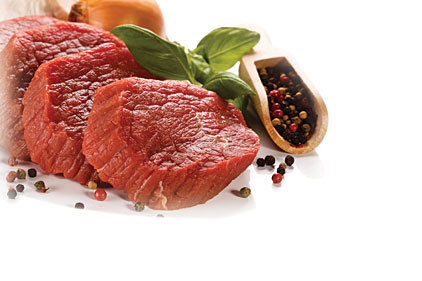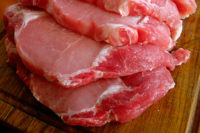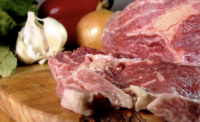A ‘portion’ of the strategy
Protein processors target consumers by meeting demand for portion-controlled products.

Meat and poultry portion sizes are on the radar of many consumers when they are shopping and even when they are dining out. Thirty-five percent of respondents in FMI’s The Power of Meat 2013 Report, who put “some effort” into choosing healthful proteins, say they “regularly” cut down on portion sizes. Another 51 percent say they “occasionally” cut down on portion sizes as part of their healthy eating strategies.
Driven by higher income shoppers, healthy eating strategies in the meat department predominately focus on purchasing leaner cuts, FMI says. Portion control, including limiting second helpings and cutting down on portion sizes, are the second and third most popular strategies. Women most frequently focus on portion control by cutting down portion sizes and second helpings, FMI’s report finds.
FMI also notes that portion control has not seen as much growth as choosing leaner cuts of meat/poultry. For example, the number of consumers who regularly choose leaner cuts jumped from 43 percent in 2012 to 53 percent this year. The number of respondents who regularly cut down on portion sizes increased from 31 percent last year.
Portion options grow at retail
More portion control meat and poultry products are available at retail, because retailers are realizing the significant amount of one- and two-person households in the United States, says Esther Palevsky, an analyst for The Freedonia Group Inc., Cleveland, Ohio.
Michael Uetz, principal at Midan Marketing, Chicago, believes that portion control is being driven by increasing populations on the extremes — millennials and boomers. Millennials, who are staying single longer or waiting to have children, and boomers, who are living longer, have different needs than shoppers feeding families.
“They are not looking for big packages of meat in the meat case anymore,” Uetz explains. “They are looking for something smaller and more appropriate to their individual needs.”
In turn, demand continues to grow for products that are convenient to prepare.
“The demand for convenience is based on limited time available for cooking from scratch and, to some degree, a likelihood of more limited capabilities in meal preparation especially among younger consumers,” Palevsky says.
In the meat case, retailers are offering precooked or partially prepared products that are typically from a major manufacturing name, Uetz adds.
Another trend is the declining consumption of red meat in the United States due to health concerns, Palevsky says. “Portion control products can be an alternative for consumers limiting the amount of meat they buy,” the analyst says.
High prices, especially in beef, are another factor driving increases in the availability of portion control products.
“Smaller packages carry a lower selling price than products packaged with larger amounts per package,” Palevsky says.
Uetz agrees that with rising retail prices consumers are becoming more conscious about what they are spending, and pre-portioned products allows them to more easily see what they are spending. The younger demographic also considers sustainability when shopping in general, which translates to purchasing less weight from the meat case.
“They don’t like to buy more than they are going to use and see all the wastefulness,” Uetz explains. “Portion size is becoming more and more important.”
Because of consumer price and size awareness, standard supermarkets are offering more exact weight ground beef products along with more exact weight cuts, such as chicken breasts and pork chops.
“Exact weight can be very useful for shoppers who don’t typically buy a certain product, but it’s requested in a specific recipe,” Uetz says. “They don’t want to buy more than they need, and, in fact, if they can buy exactly a 1 pound or a 2 pound or exactly what is called for, then it takes some of the waste out of the packaging.”
At retail, individually wrapped portions are popular in chicken and fish since these enable consumers to use the amount needed, while the remainder can be frozen for later use. In frozen fish, single pieces in vacuum pouches are popular because they can be separated easily. Some portion control frozen fish products use self-venting film for microwave preparation in the package as well. Also, a growing number of products are available in cook-in-bag form. Products like small roasts, turkey breasts, or hams can be placed in the oven in these bags and eliminate the need to directly handle raw products, Palevsky explains.
In the 2013 Power of Meat report, 49 percent of consumers reported that they would buy protein in bulk if the product was actually pre-portioned for meal-sized quantities. Perforated packaging of vacuum packs of chicken and pork cuts, which once were only available in club stores, are transitioning into mainstream grocery stores, Uetz says. Consumers have the opportunity to buy several products in one package, but only have to pull off the product that they are going to use for that meal. They can easily freeze the rest, which “truly meets the consumers’ needs,” Uetz says.
In the full-service case, the introduction of more pre-made burger patties, kabobs, and seasoned and marinated meats and poultries really speak to portion control opportunity because shoppers can pick out exactly what they want. In addition, more individual cuts of specialty meat that are natural or organic, such as individual tenderloin that is bacon wrapped, are starting to grow.
“The price point was price prohibitive when they were first introduced, but now especially with the needs of Millennials and Boomers, there is more of an opportunity for all those kinds of products,” Uetz says.
Dining out portions
Even in restaurants, consumers are looking for more healthful options. Eight-six percent of adults surveyed by the National Restaurant Association (NRA), Washington, D.C., said more healthful options are available at restaurants than there were two years ago.
In turn, restaurants are providing more portion sizes from which consumers can choose, says Joy Dubost, NRA’s director of nutrition and healthy living. “Smaller portions or half portions are a top trend in the industry,” she says.
While mini desserts are the top trend in offering smaller portions at restaurants, within NRA’s main dish/center of the plate category the No. 5 trend is half portions/smaller portions.
In research conducted by Technomic Inc., Chicago, the research firm asked, “What are some of the tactics you use at restaurants when you want to eat healthfully?” Portion size is one of respondents’ methods, says Kelly Weikel, a senior consumer research manager at Technomic. About one-fifth of consumers said that when they want to eat healthfully at a restaurant, they usually or always consider a smaller portion size, Technomic reports. That number didn’t shift from 2010 to 2012.
Smaller portion sizes not only help limit calories for patrons but also can promote sharing. For example, sharing small plates has become trendy in restaurants’ social setting. “People like trying different samples of many options,” Dubost explains.
Small plates also speak to a shift in dieting habits from three full traditional meals and more toward snacking, Weikel says.
“It’s really based on giving consumers something that they can get as a snack or a small bite rather than a full meal, trying to hit those off-peak meal times,” she explains. “They might be coming in for just a drink, but if there is something small on the menu, they might get that rather than just a beverage.”
As for value, it used to depend on larger portions. For example, if you got a lot of food, a customer could justify the higher price point, Weikel explains.
“Now that consumers are a little bit more demanding in terms of quality and freshness that’s changed a little bit too where they are fine with a smaller portion size if they can have higher quality foods,” she says. “To some extent, the recession had a little bit of an impact on that too by saying, ‘I can’t go to a restaurant and order a full steak, but maybe I can get a small plate with something like that in there.’”
Weikel also believes higher commodity prices are having an impact, with operators trying to decrease portion sizes to keep food costs in line.
“Smaller portions aren’t always less expensive, but it does allow consumers to get things that they might not be able to purchase if it were a larger portion size,” she says. “It also helps in terms of them wanting to add a food item if they see something on the menu that’s $5 or less that they can get just as a light bite or a snack.”
Since “small plates” are popular on restaurant menus, this could promote introductions of new products in portion control sizes, Freedonia’s Palevsky adds. However, significant change may not occur in the near future, she says.
While the press has linked portion size to obesity and some restaurants have added calorie information to their menus, Palevsky still doesn’t feel this affects buying habits for protein products that much. However, portion size is a big way restaurant operators can get calorie counts down on menus without sacrificing the taste, Technomic’s Weikel says.
“They are going to keep the same option, but they are going to give you less of it,” she says. “When that calorie count has to be on the menu, it’s not going to be so startling. We all pretty much know that there are going to be consumers who aren’t going to pay much attention to those calorie counts anyway, but some might, and if some are looking for calories under a certain threshold, those smaller portion items might be the ones that they get because it meets their needs in that area.”
Looking for a reprint of this article?
From high-res PDFs to custom plaques, order your copy today!







